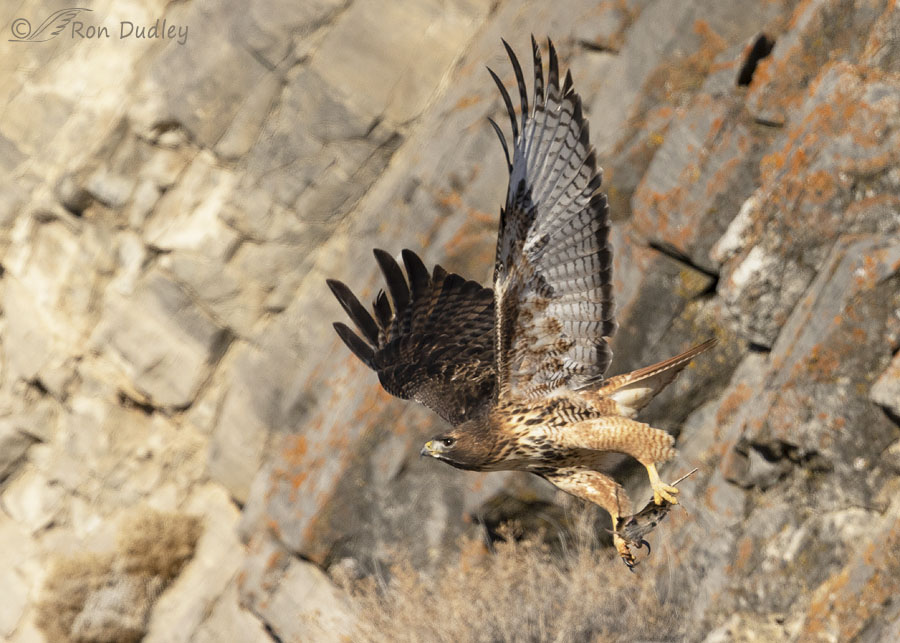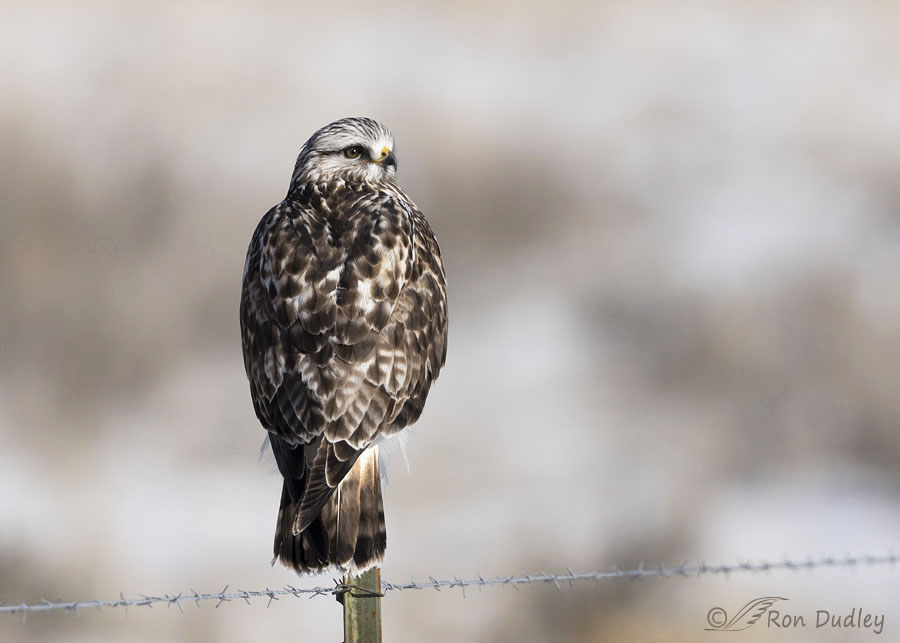Yesterday an old problem reared its ugly head again. A problem I thought I’d solved.

1/6400, f/5.6, ISO 640, Canon R5, Canon EF500mm f/4L IS II USM + 1.4 tc, not baited, set up or called in
Early in the morning a truck hauling hay approached from in front of me and spooked this adult Red-tailed Hawk out of a tree next to the dirt road I was on. I’d spotted the hawk in the tree only seconds before ‘she’ spooked so the series of flight photos I got were grab shots. I didn’t realize that she had a vole in her talons until I got home and looked at my photos on the big screen.
I could appreciate the photo a lot more if it were sharper. It should be sharp but it isn’t and that becomes even more apparent at a larger size than this. It’s actually the sharpest shot I got in the series. I’m confident that the softness was caused by temperature disparity between my lens and the outside air – a common problem I thought I’d largely solved by bundling up in warm clothes, using my seat warmers and keeping the interior of my pickup, and thus my lens, uncomfortably cold.
It’s worked in the recent past but not yesterday. Outside temps varied between 10° and 22° F. and I kept my lens cold the entire time but the vast majority of my photos were softer than they should have been. Some were eye-wateringly soft. That hurt because I had good opportunities with Bald Eagles in flight (an adult and an immature bird) and Gray Partridges foraging in snow and in flight. All of those photos, and others with potential, are garbage.
So I’m back to square one. And discouraged. And suddenly anticipating spring and warmer temperatures even more than I was the day before.
Ron
Addendum:
There’s no rhyme or reason I can see to explain the pattern of sharp and soft photos I got yesterday.

1/5000, f/5.6, ISO 400, Canon R5, Canon EF500mm f/4L IS II USM + 1.4 tc, not baited, set up or called in
About the only truly sharp shots I got were of this Rough-legged Hawk. Photos taken earlier in the morning than this, when it was colder, were soft. As were photos taken later than this when it was warmer. And I kept my lens “cold” the entire time.
A head scratcher.


I have nothing to add to the lens-temp-softness conundrum, but I will say that’s one gorgeous Red Tail — even with the broken primary. And the Roughie is a looker as well.
I have the same “soft” photos problem in the winter. One thing I’ve noticed is that if I’ve been driving for awhile before parking my mobile blind, heat radiating from the engine off the hood tends to interfere with getting a good focus, depending on what angle I’m pointing the camera and any prevailing air currents. This can also happen in the summer when the air is very hot and I can see the heat waves through my viewfinder. I shoot with a Nikon P1000, so it may be related to having a different type of (and much less expensive) gear than you. Just a thought I’m throwing into the pot for you to mull over.
Karen, what you describe in the 2nd part of your comment is common with many of us – no matter the cost of the gear. That’s part (only part) of the reason I always shoot in the early morning in summer – when those kinds of heat waves are less of a problem.
Nothing to offer for your dilemma, sorry you’ve got this frustration again … but I’m happy you’re seeing such fine raptors out there. Fingers X’d you’ll see more of them in coming days and the softness issue will magically disappear, if no other, more concrete steps resolve it. 🪄🧞♂️
Thanks for your good wishes, Chris. We can only hope…
Ron,
I have had the same problem when shooting at night in the cold. I have had condensation and ice crystals form on the lens with out of focus stars as a result. Some experienced night photographers recommend “dew heaters” for this and I have purchased two but I have not yet tried this solution (probably this weekend). It seems counterintuitive to the “keeping the lens cold” theory. This also happened while on vacation in a tropical country early in the morning when the cold (hotel AC) lens hit the hot humid air. That was the worst and I will remember the shots I missed that morning forever (POW camp where American soldiers were held in Viet Nam).
Just a thought.
Stephen
Stephen, I’ve never had a problem with condensation. Not once. One of the advantages of living in an area with consistent low humidity.
I thought that must be a particularly meaty leaf in the those talons. The smaller I make the RTHA photo the sharper it gets😃
Beautiful shot of the Roughie.
As the world expert in cold weather photography (that would be ﹤70º for me) I wonder if the camera and/or the lens slows down so maybe try single shots rather bursts and manual rather than auto focus. Things I’m sure you never thought of.
“The smaller I make the RTHA photo the sharper it gets”
Exactly, Lyle.
Manual focus and birds are an unproductive mix. And I take a lot of single shots – doesn’t make any difference.
Ron, it sounds like you have tried lots of things to resolve this issue, so I doubt I can add anything… I presume you are relatively confident the softness is not due to heat distortion in between you and the subject. But the photo of the red-tailed hawk launching off rocks makes me think the rocks closer to you could possibly be heating up with the sun and causing heat waves.
Another slight possibility is that despite your best efforts to cool the lens there is still enough temperature difference with the cold outside air to cause a problem, perhaps exacerbated by using a lens hood if you do. I saw a video by Steve Perry (Backcountry Gallery) a year ago where he found simply removing his lens hood gave an immediate drastic improvement in sharpness. It seems his situation was also in cold shooting conditions, but he perhaps had more warmth in his lens, but it could be worth checking out.
Good luck in resolving this.
Duane, last winter when I was having this same problem I shot for several days without my lens hood. For me it seemed to make little if any difference. And having no protection for that expensive front lens element made me nervous as hell.
You are such a perfectionist, Ron. As a non-professional, I think your pics are always incredible!
Thanks, Larry. With all the money I have invested in top-of-the-line camera gear I want my photos to be as good as they can be. And should be.
I was thinking about the possibility of keeping a camping cooler in your truck during the night, and placing your gear in the cooler as you get into the truck, by the time you’re out in the field, your gear might be at something closer to temperature parity with the atmosphere ?
Kris, I started cooling my lens down 35 minutes before I got on site. And I was shooting for nearly three hours with the lens cold but the problem persisted most of that time (except for the Rough-legged Hawk).
No space after addendum for me. I was thinking perhaps the air disturbance from the truck created problems but that wouldn’t explain the eagles. Even with the heat IN your pickup off there would still be heat from the engine – don’t know how calm the air was. Frustrating to say the least! Still like the shot!
“No space after addendum for me.”
Thanks for that feedback, Judy. I was beginning to worry.
This photo seems fairly sharp and interesting as always with the in flight hawk, but sorry about the rest of the photos. I am not knowledgeable enough regarding the technical side of photography to comment, but I am sure some of your followers can and will offer advice.
There is a large blank space after the addendum – should there be?
Everett, I’m not seeing “a large blank space” and no, there shouldn’t be one. There should be a second photo there. I hope others aren’t seeing a blank space….
Ron: Believe it or not we have the same problem down here in southern Arizona. On some winter mornings temperatures will be down in the low 30s or even upper 20s. When I photograph I leave the heat off in my vehicle and the windows open, but even with that, I usually get annoyingly soft images for the first 45 minutes or so of my field work. The sharpness improves as the outside temperature goes up.
Steven, what you describe has been pretty close to my experience.
Have you tried a12 volt heated blanket option and wrapping the lens all the way out over the hood to keep it warm? maybe even your hands inside.
Thomas, keeping my lens warm is the last thing I want. Seems to me that would only exaggerate the problem when I stick my lens out the window into the cold air.
it is the idea of keeping it a constant temperature, to minimize glass movement, Be it warm or be it cold and if the temperature of hours of non use is the same as when shooting you are doing the concept I present. KEep up the good work I have enjoyed it for years.